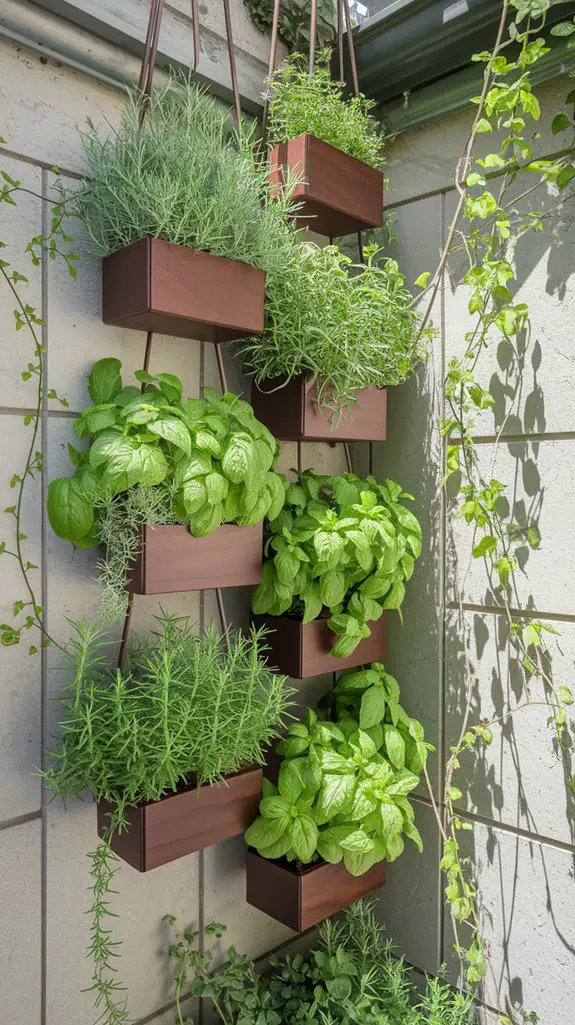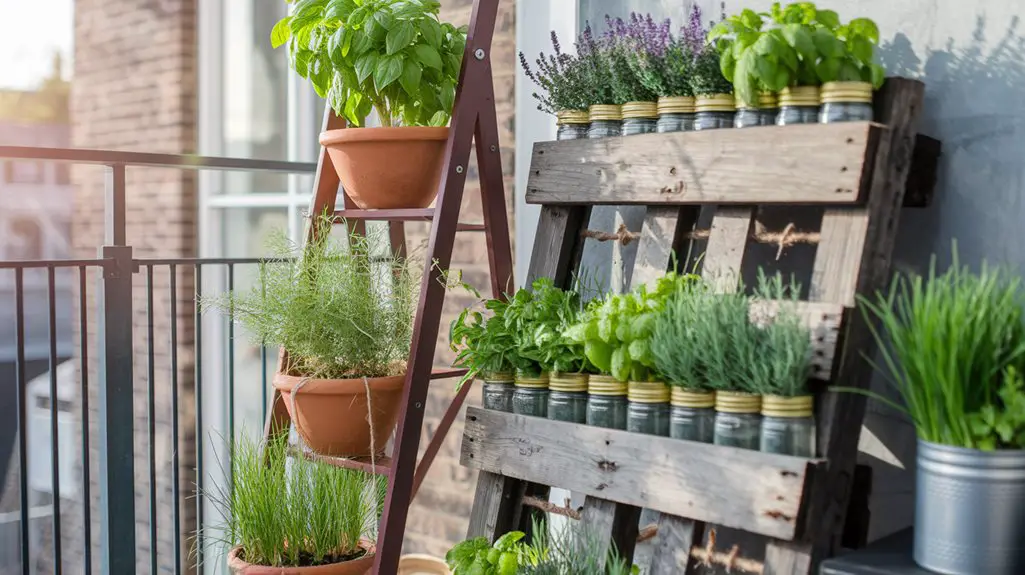You don't need a sprawling backyard to grow fresh herbs. Even the smallest spaces can become productive herb gardens with the right approach. Whether you're dealing with a tiny apartment balcony, a narrow windowsill, or just a bare kitchen wall, creative solutions exist. From vertical planters to hydroponic systems, these ten unique herb garden ideas will help you maximize your space while ensuring you've always got fresh flavors within arm's reach.
Vertical Herb Wall Gardens for Tight Spaces
When space comes at a premium, vertical herb wall gardens offer an ingenious solution for urban dwellers and small-space gardeners.
You'll maximize your growing area by utilizing walls instead of valuable floor space, instantly transforming blank vertical surfaces into productive herb havens.
Start with pocket planters, repurposed pallets, or specialized vertical gardening systems that attach securely to walls.
Choose herbs based on your wall's sun exposure—thyme, rosemary, and sage thrive in sunny spots, while mint and parsley tolerate partial shade.
Install a simple irrigation system with a timer to guarantee consistent watering without daily maintenance.
Position your vertical garden near the kitchen for easy harvest while cooking, and arrange herbs by water needs, placing thirsty varieties at the bottom to catch runoff from plants above. Additionally, consider specialized vertical gardening systems that can enhance your overall herb-growing experience.
Upcycled Container Herb Gardens

Transforming everyday household items into productive herb containers not only saves money but also reduces waste while adding unique character to your growing space.
Old teapots, wooden crates, and tin cans make perfect homes for herbs like mint, basil, and chives. Simply drill drainage holes in the bottom, fill with quality potting soil, and you're ready to plant.
Mason jars work well for moisture-loving herbs—just add pebbles at the bottom for drainage.
Don't overlook unexpected items like old boots, colanders, or unused kitchen utensil holders. Place your upcycled containers near a sunny window or hang them with repurposed chains to maximize light exposure.
Group herbs with similar water needs together to simplify maintenance. Label each container with paint pens or recycled wine corks for an organized, sustainable herb garden. Incorporating edible landscaping ideas can further enhance the beauty and functionality of your garden space.
Hanging Herb Planters for Backyard Corners

Backyard corners often remain neglected and underutilized, yet they're perfect spots for hanging herb planters that maximize vertical space while adding greenery to otherwise empty areas.
Install corner bracket systems or shepherd's hooks to support multiple hanging baskets at different heights, creating a cascading effect that's both functional and visually appealing.
Choose lightweight containers like macramé hangers or repurposed plastic bottles for herbs that don't require deep soil, such as thyme, oregano, and mint.
For corner fence posts, try installing rain gutter segments diagonally to create tiered planting spaces.
Don't forget to take into account sunlight patterns—place sun-loving herbs like basil and rosemary in higher positions, while shade-tolerant herbs like parsley and cilantro can thrive lower down where they'll receive filtered light. Additionally, incorporating fragrant herbs into your garden can enhance the sensory experience and attract beneficial pollinators.
Tiered Herb Garden Shelving Units

Tiered herb garden shelving units offer a structured approach to small-space herb growing that takes advantage of vertical real estate while keeping everything neatly organized.
You'll find these units in various materials—reclaimed wood for rustic charm, metal for industrial style, or plastic for budget-friendly durability.
When setting up your tiered system, place sun-loving herbs like basil and rosemary on upper shelves, with shade-tolerant varieties like mint and parsley below.
Add casters to the bottom for mobility, allowing you to follow the sun or bring plants indoors during bad weather.
For maximum efficiency, integrate a drip irrigation system between tiers so water cascades down, nourishing all plants while minimizing waste.
Consider adding small hooks to hang garden tools, ensuring everything you need stays within arm's reach. Additionally, incorporating pollinator-friendly herbs can help attract beneficial insects to your garden, enhancing its productivity and health.
Window Box Herb Gardens for Easy Access

Three key advantages make window box herb gardens perfect for small spaces: proximity to cooking areas, abundant natural light, and eye-level maintenance.
Mount boxes directly beneath kitchen windows for instant access to fresh herbs while cooking. You'll save precious countertop and floor space while utilizing underused window areas.
Choose weather-resistant containers with proper drainage and secure mounting hardware to prevent accidents.
Opt for shallow-rooted herbs like thyme, chives, and oregano that thrive in limited soil depth. Mix trailing varieties like creeping rosemary with upright basil for visual interest.
In winter, detach boxes and bring herbs indoors, or install boxes on interior windowsills year-round.
Add a small watering system with drip irrigation to guarantee consistent moisture without the mess of overwatering your sills. Additionally, ensure regular maintenance of raised garden beds to keep your herbs healthy and thriving.
Spiral Herb Garden Designs for Small Yards
While traditional gardens spread horizontally, spiral herb gardens rise upward in a stunning helix pattern that maximizes growing space in the smallest yard footprint.
You'll create microclimates as the spiral ascends, with sun-loving herbs at the top and shade-preferring varieties below.
Building your own spiral requires minimal materials but delivers maximum impact:
- Use local stones, bricks, or recycled materials to construct the spiral structure
- Create different soil conditions in various sections for herb-specific needs
- Plant drought-tolerant herbs at the top and moisture-loving varieties at the base
- Incorporate small paths between plantings for easy harvesting without trampling
This space-efficient design brings visual interest to your landscape while creating perfect growing conditions for diverse herbs in just a few square feet. Additionally, these gardens can be created using budget-friendly materials that are easily accessible and affordable for anyone looking to start their own herb garden.
Pallet Herb Gardens for Vertical Growing
Wooden shipping pallets transform into space-saving vertical herb gardens that let you grow a bounty of culinary and medicinal plants without sacrificing precious floor space.
You'll find these reclaimed structures readily available behind stores or on marketplace sites, often for free.
To create your pallet garden, first sand rough edges and consider sealing the wood if it's not heat-treated.
Staple landscape fabric to the back and bottom to hold soil.
Position your pallet against a sunny wall or fence, then plant herbs between the slats.
Thyme and oregano work well in upper sections where drainage is excellent, while moisture-loving mint and parsley thrive in lower rows.
For added functionality, attach small containers to the front for harvesting scissors or plant markers, maximizing organization in your compact vertical herb haven.
Additionally, utilizing raised garden beds can further enhance your organic gardening experience by providing improved soil quality and drainage.
Tabletop Mini Herb Gardens
Tabletop mini herb gardens offer five fantastic solutions for apartment dwellers, renters, or anyone with limited outdoor space to grow fresh herbs year-round.
These compact gardens maximize efficiency while adding a touch of greenery to your kitchen or dining area. You'll enjoy fresh herbs within arm's reach while cooking, eliminating waste and saving money.
- Use repurposed containers like teacups, mason jars, or tin cans to create charming sustainable planters.
- Group herbs with similar water needs together (rosemary and thyme prefer drier soil than basil and mint).
- Install a grow light above your tabletop garden for winter months when sunlight is limited.
- Choose compact herb varieties like spicy globe basil or dwarf sage to maximize your small space.
Consider creating a vertical herb garden to further optimize your limited space and enhance your indoor gardening experience.
Rotate your containers regularly to guarantee even sunlight exposure for all plants.
Herb-Specific Container Combinations
Beyond individual herb containers, thoughtful herb-specific combinations allow you to create harmonious mini-ecosystems that thrive together.
Group Mediterranean herbs like rosemary, thyme, and oregano in sandy, well-draining soil with full sun exposure. They'll share similar water needs and create a drought-resistant display.
For kitchen convenience, combine frequent cooking companions—basil, parsley, and chives make perfect roommates in a windowsill planter.
Mint varieties work beautifully together but keep them contained as they'll quickly overtake other herbs.
Don't forget visual appeal—pair tall dill or fennel with cascading thyme and bushy basil for dimension.
Consider flavor profiles, too—citrus-scented herbs like lemon verbena and lemongrass complement each other perfectly. Additionally, growing your own herbs can provide health benefits that enhance your overall well-being.
Just verify all grouped plants share similar light, water, and soil requirements for sustainable growth in your limited space.
Hydroponic Herb Systems for Space-Saving Growth
Hydroponic herb systems eliminate soil entirely, offering perhaps the most efficient solution for ultra-compact spaces.
These modern growing methods use nutrient-rich water to cultivate herbs in a fraction of the space traditional pots require. You'll enjoy continuous harvests year-round without dealing with soil-borne pests or diseases.
- Wall-mounted vertical hydroponic units maximize unused vertical space while creating living art
- Countertop systems with built-in LED lights fit perfectly in kitchens for immediate cooking access
- Smart hydroponic gardens automatically monitor water levels and nutrient needs
- Stackable hydroponic towers can grow up to 20 herbs in the footprint of a single pot
For apartment dwellers or anyone with limited sunlight, these systems provide an ideal solution, allowing you to grow flavorful herbs regardless of outdoor conditions.
Conclusion
With these compact herb garden ideas, you'll transform tiny spaces into productive culinary corners like a magician turning scarves into doves. Whether you're hanging planters, stacking shelves, or growing vertically, you're maximizing every inch while embracing sustainability. Your small-space herb garden isn't just practical—it's a statement that fresh flavors don't require sprawling gardens. Start small, think creatively, and watch your herb collection thrive.




